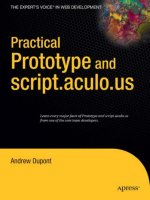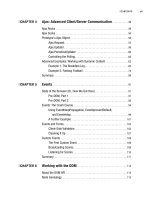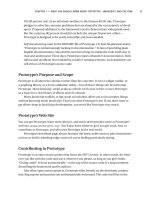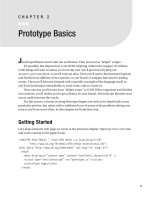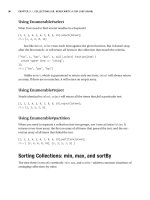Practical prototype and scipt.aculo.us part 3 pot
Bạn đang xem bản rút gọn của tài liệu. Xem và tải ngay bản đầy đủ của tài liệu tại đây (86.68 KB, 6 trang )
About the Technical Reviewer
After getting hooked on the Web in 1996 and spending several years pushing pixels and
bits for the likes of IBM and Konica Minolta, AARON GUSTAFSON founded his own web
consultancy: Easy! Designs. Aaron is a member of the Web Standards Project (WaSP)
and the Guild of Accessible Web Designers (GAWDS). He also serves as a technical edi-
tor for A List Apart, is a contributing writer for Digital Web Magazine and MSDN, and
has built a small library of writing and editing credits in the print world, including con-
tributions to AdvancED DOM Scripting (friends of ED, 2007), Accelerated DOM Script-
ing with Ajax, APIs, and Libraries (Apress, 2007), and Web Design in a Nutshell, Third
Edition (O’Reilly, 2006). Aaron has graced the stage at numerous conferences, including
An Event Apart, COMDEX, South by Southwest, the Ajax Experience, and Web Direc-
tions, and he is frequently called on to provide web standards training in both the pub-
lic and private sectors.
He blogs at
.
xv
Acknowledgments
Anumber of forces conspired to help me finish this book, despite my best efforts not
to. Aaron Gustafson was a great help as technical editor and gave thoughtful code cri-
tiques. The patient, stoic folks at Apress gave me constructive encouragement through-
out the slow, arduous process. Christophe Porteneuve, having written a book on the
same subject, gave me tips on several occasions.
I am also grateful to Sam Stephenson, both for creating Prototype and for inviting
me to be a part of Prototype Core. Other team members gave critical moral support:
Thomas Fuchs, Tobie Langel, Mislav Marohnic, and Justin Palmer.
Objects, as well as people, were instrumental in the completion of this book:
a MacBook Pro, TextMate, Parallels Desktop, and sugar-free Red Bull. I thank them for
their support.
xvii
Introduction
Iwrote this book for people who have some experience with JavaScript and no experi-
ence with Prototype. I mean for “experience with JavaScript” to cast a wide net: you
may love JavaScript, or hate it, or love the language but hate browser scripting, or love
both, or hate both.
Because the book assumes some JavaScript experience, it does not cover the most
basic parts of the JavaScript language itself, nor does it cover the DOM. There are
many books that can get you started on that path, but the best free resource is Quirks
Mode (
www.quirksmode.org), the authoritative and exhaustive reference created by
Peter-Paul Koch.
This book is also meant to appeal to those who have some experience with Proto-
type but don’t consider themselves experts. Many have worked with Prototype indirectly
through Ruby on Rails or a similar framework. Many have used a third-party script that
depended on Prototype, but treated the code as a black box.
In the first chapter of the book, we’ll look at some aspects of the JavaScript language
that novice users may not know about. Feel free to spend as much time on Chapter 1 as
you need, since it’s crucial that you understand these concepts if you want to use Proto-
type effectively.
The screenshots in this book show Firefox running on Windows XP, but the code
examples are designed to work in all major browsers and on all major platforms. Proto-
type boasts official support for Firefox (versions 1.5 and above), Internet Explorer (6 and
above), Safari (2 and above), and Opera (9.2 and above).
I welcome your feedback, observations, and ridicule. I can be reached at
xix
Prototype
PART 1
What You Should Know
About Prototype, JavaScript,
and the DOM
Before jumping into the deep end, you should learn about where Prototype comes
from—its purpose, origin, and philosophy. We’ll also discuss what differentiates Proto-
type from other libraries.
First, though, we need to make sure we’re on the same page. This book assumes
a basic familiarity with JavaScript and the DOM, but that’s a vague prerequisite, and
JavaScript is a language both broad and deep.
In case you need a refresher, here’s a crash course in topics that will be built upon in
the chapters to follow.
About JavaScript
George Orwell once wrote that writing JavaScript “is a horrible, exhausting struggle, like
a long bout of some painful illness. One would never undertake such a thing if one were
not dr
iven on by some demon whom one can neither resist nor understand.”
OK, that’s a lie. He actually said that about writing
books.K
eep in mind, though, that
JavaScript had not yet been created in Orwell’s time, and that a modern-day Orwell might
have eschewed prose in favor of
progr
amming
, a far higher artistic pursuit.
I feel this way about Jav
aScript, at the very least. It’s a brilliant language with very
public flaws. It was created hastily and standardized prematurely. The JavaScript envi-
ronments within browsers vary wildly in spec compliance, language features, and speed.
It’s a language whose ideals are compromised by the imperfect state of today’s Web.
We’ll talk about ways to mitigate these flaws. But first let’s look at some of the things
that make JavaScript brilliant.
3
CHAPTER 1
Everything Is an Object
The sooner you embrace this concept, the more quickly you’ll understand Prototype:
everything in JavaScript is an object. This has several different meanings and several
different implications, which are outlined in the following subsections.
All Data Types Have Instance Methods
Like other languages that embrace object orientation, every object can have instance
methods. This allows for flexible syntax and makes code easier to read.
["foo", "bar", "baz"].join(' ');
//=> "foo bar baz"
"foo bar baz".split(' ');
//-> ["foo", "bar", "baz"]
It also ensures that functions don’t clutter up the global namespace. What’s the use
of a generic
join function, for instance, if it works only on arrays? Or a generic split that
works only on strings?
All Data Types Inherit from Object
JavaScript boasts half a dozen native data types: Object, String, Array, RegExp (for regular
expressions),
Boolean (true or false), and Date.
I place
Object first because it’s the root data type. When I say that everything in
JavaScript is an object, I also mean that everything in JavaScript is an
Object. Confused?
Let me explain.
Object can be thought of as a blank data type, the empty canvas that all other types
start with. There is nothing
Object does that another type can’t do, but then that’s the
point:
Objects can bend to your will.
But back to the main point: Everything in JavaScript is an
Object. We can verify this
with the
instanceof operator on some core JavaScript data types:
Array instanceof Object;
//-> true
RegExp instanceof Object;
//-> true
Date instanceof Object;
//-> true
String instanceof Object;
//-> true
Function instanceof Object;
//-> true
CHAPTER 1 ■ WHAT YOU SHOULD KNOW ABOUT PROTOTYPE, JAVASCRIPT, AND THE DOM4
